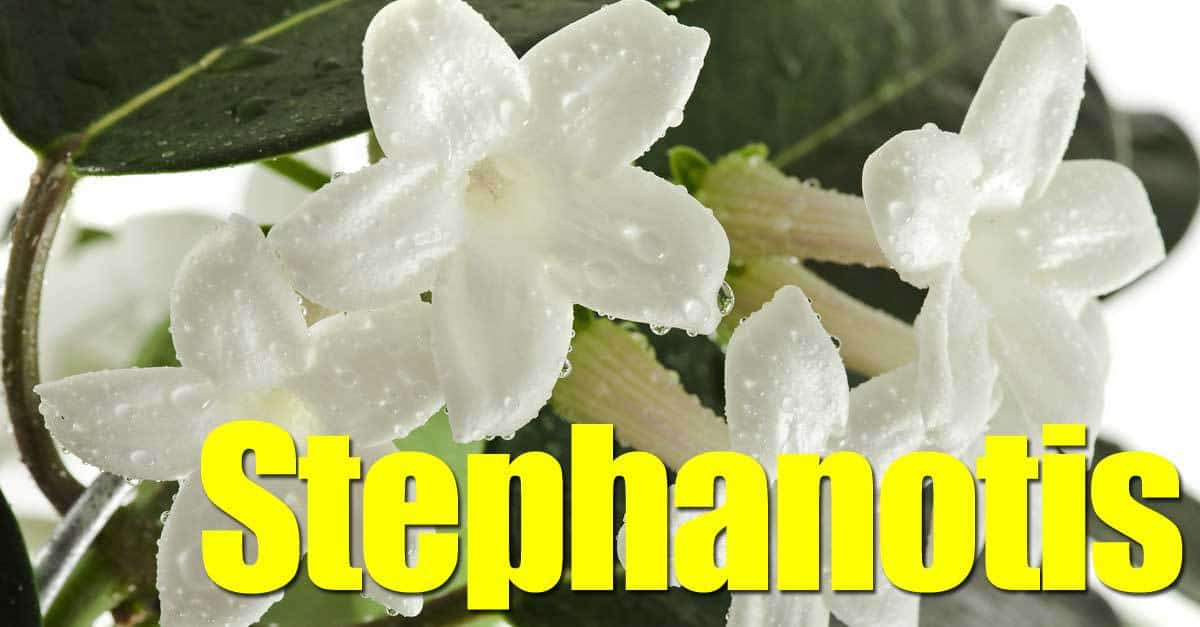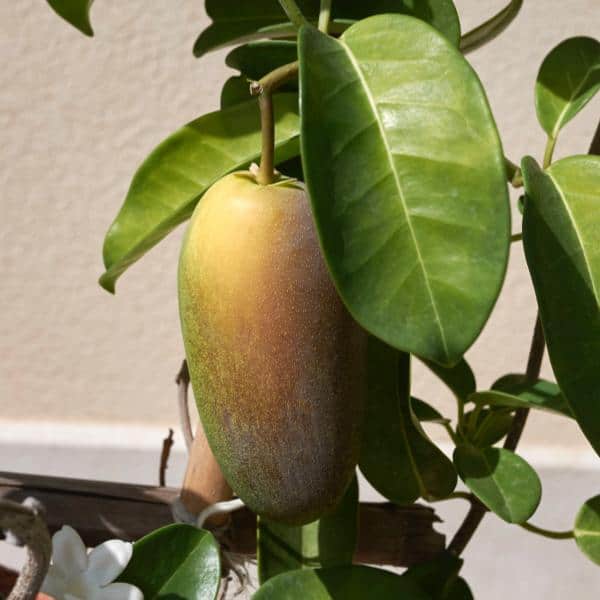Summary: Stephanotis, a long time favorite, fragrant, bridal veil plant, and has grown in popularity as a spring-time patio plant. It grows on a trellis and in a hanging basket.
Stephanotis floribunda (stef-ah-NO-tis flor-ih-BUN-duh) hails from Madagascar and is a member of the Apocynaceae (a-pos-ih-NAY-see-eye) or milkweed family.

The genus name, Stephanotis, is taken from the Greek words meaning crown (stephanos) and ear (otos). It is a reference to the earlike structures that are to be found in the centers of the flower.
The specific epithet, floribunda, means free-flowering or having many flowers.
Common names include:
- Bridal Veil Plant
- Hawaiian Wedding Flower
- Madagascar Jasmine
- Bridal Bouquet
- Wax Flower
It is important to note that, although this plant resembles jasmine, it is not related. True jasmine is a member of the olive or Oleaceae (oh-lee-AY-see-eye)family.
The plant is a perennial in its native tropical settings of Madagascar. It is typically kept as a houseplant in North America. It is winter hardy in USDA hardiness zones 10 and warmer.
The Stephanotis plant has grown in popularity over the past few years along with some of the other spring flowering vines like Mandevilla.
Stephanotis Plant And Flower Care
Size & Growth
Stephanotis floribunda, aka Madagascar jasmine or wax flower, is a wiry twiner with opposite, oblong, thick, glossy deep green leathery leave about 4″ inches long. Both sides of the leaves are very attractive.
This rambling, vining plant can grow to be more than ten feet long.
The plants’ stems are woody and thick but are usually flexible. They can easily be trained to climb a wire structure.
The real beauty of this bridal veil plant is the scented white stephanotis blooms against the deep green leaves.
Flowering & Fragrance
The Hawaiian Wedding Flower has deeply fragrant, tubular, star-shaped, waxy flowers that grow in clusters.
If the plant receives ample light, humidity, and warmth, it can bloom year-round. It is especially likely to produce good blooms if it is kept outdoors during the warmest months of the year.
In cool regions, it can be hard to get Madagascar Jasmine to bloom.
You can spur Stephanotis on by providing a rest period at slightly cooler temperatures during the winter and then moving it to a warm, sunny setting in the spring and summer months.
After buds appear, protect the plant from chill as this may cause the buds to drop.
The clusters of tubular white flower, most abundant in June are deliciously fragrant.
The fragrant flowers commonly used as a wedding flower in bridal bouquets or wedding bouquets earned the common name of “Bridal Veil Flower” or “Bridal Wreath.”
Light & Temperature
Bridal veil plant should receive plenty of bright, indirect sunlight. It also benefits from a couple of hours of direct sunlight daily.
Protect the plant from scorching sunlight or excessive dry heat.
In the wintertime, keep your Bridal Bouquet plant at temperatures ranging from 55°- 60° degrees Fahrenheit.
During the growing season, 65° – 80° degrees Fahrenheit is ideal. Never allow the temperature to drop below 39° degrees Fahrenheit.
Watering & Feeding
During the growing season (spring and summer), water the Wax Flower thoroughly, occasionally.
When the top of the soil starts to dry out, give the plant a deep watering using distilled water or rain water.
The bridal veil plant suffers more harm from overwatering than under-watering.
In the wintertime, water seldom and lightly. Just give the plant a little drink when the top one-inch of soil has become very dry.
In the summertime, or during dry winter months indoors, you may need to provide extra humidity. You can do this by misting and/or providing a humidifier or pebble tray.
Flowering forces plants to use up a lot of food. Applying a good, well-balanced plant food will help keep plants healthy and flowering longer.
Fertilize with a balanced liquid fertilizer throughout the growing season. Follow packaging instructions closely. [source]
- Feed biweekly using a soluble liquid food like miracle-gro plant food in spring, summer, and fall.
- Withholding plant food reduces the amount of watering slightly, and lower temperature in winter.
If you are repotting, remember these plants are sensitive to overwatering.
Stephanotis is very responsive to warm temperatures, good, fertile, well-drained soil, and requires a minimum of 55° degrees Fahrenheit.
Soil & Transplanting
As with many tropicals, Stephanotis prefers a light, airy, a well-drained soil potting medium. A good mix consists of:
- 2 parts Peat Moss
- 1 part Vermiculite
You needn’t repot this plant frequently. Once every couple of years, early in the springtime is a good schedule.
Grooming & Maintenance
Madagascar Jasmine usually comes attached to a wire frame or trellis although I have seen the plant grown as a basket.
Remove any strings or wires holding the plant in place as these may cut into the stems and kill the plant.
To produce a compact plant prune and train the vines around a supporting trellis or basket.
Pruning is unnecessary and does not encourage the plant to produce new growth.
Trim away shoots that are damaged or sickly. Trim lightly from time-to-time to shape the plant as you wish.
Growing stephanotis floribunda may result in the plant growing all over the place.
How To Propagate Stephanotis Plant And Flower
Propagate Stephanotis from stem cuttings and seed. I have rooted cuttings a few times, but the experts advise:
Propagate From Stem Cuttings
- In spring, cut half-mature stem tips with three or four joints from half-ripe wood
- Dip in rooting hormone powder
- Root in peat and coarse sand or a soilless growing medium
- Keep humidity high
- Place in a warm (70° degrees Fahrenheit) humid setting with indirect lighting.
- Covering the cutting with a plastic bag will help keep moisture in.
- Keep warm and in high humidity until roots form.
- Transplant once roots become established
Propagate From Seed
Stephanotis will grow from seed, but it is a very slow process.
Seeds are hard to come by, and you must keep them uniformly warm and well protected for quite some time before seeing germination.

The seedpod reaches the size of a medium to large pear.
The seedpod remains on the plant for over six months before the seeds are ready for harvest.
You will not see an abundance of seed pods on a vine.
In fact, over the last 40 years, I have only seen five pods produced on a rather large vine.
This page has some good photos on the seed pod.
Seeds germinate readily in warmth and humidity.
Stephanotis Plant And Flower Pest or Disease Problems
Incorrect lighting, temperature, and humidity may cause your Bridal veil plant not to bloom. If you do not provide a winter rest period, your plant may not bloom.
Moving your plant around or exposing it to cold drafts may cause bud drop. Providing the wrong amount of water may also cause this problem. When this happens, emerging buds fall without opening.
Lower leaves naturally yellow and drop, but if you notice an excessive amount of leaf drop from higher up the stems, you may not be watering enough, or the water may be too hard.
Sudden cold snaps can also cause this problem.
Sudden exposure to hot sun will cause the leaves to blister.
Bridal Bouquet can be subject to infestation by scale insects and mealybugs.
Check frequently – remove these pests with a blast of water rather than having to resort to chemical solutions.
For severe infestations use natural organic Neem Oil for control.
Is Stephanotis Toxic or Poisonous to People, Kids, Pets?
Hawaiian Wedding Flower is non-toxic to cats and dogs. Australian Possums are especially fond of the leaves!
Is Stephanotis Considered Invasive?
Madagascar Jasmine is not listed as invasive.
Suggested Uses For Stephanotis Vines
Madagascar Jasmine is a beautiful climbing plant that can do well outdoors in tropical settings. It makes a wonderful container with a trellis or in hanging baskets to move in during winter and out during summer in USDA plant hardiness zones cooler than Zone 10.
The pretty, fragrant white flowers are very popular for use in wreaths, bridal bouquets and the like.
Kept as a houseplant, Wax Flower makes an attractive conversation piece when trained to climb a small trellis.
Popular Greenhouse Addition
This twining tropical vine with thick, glossy, waxy oval leaves and summer clusters of small waxy, tubular fragrant white blooms makes for a perfect greenhouse subject in the North.
In the south grow the Madagascar jasmine over a trellis, on other supports or even.
The vines need warmth (65° degrees Fahrenheit minimum) and moisture during the bud-setting season.
Provide full sun except in midsummer heat. Keep plants slightly cooler and drier during the winter rest period.
Soil should be extra rich in humus. Prune after flowering, in early fall.
Family: Apocynaceae
Common Name: Madagascar Jasmine
